If, like us, you enjoy taking your dog to the lake or river during warm weather months, be aware of the possibility of Blue-Green Algae, toxic to dogs. Please be sure to read about this Cyanobacteria and how you can identify and avoid it!
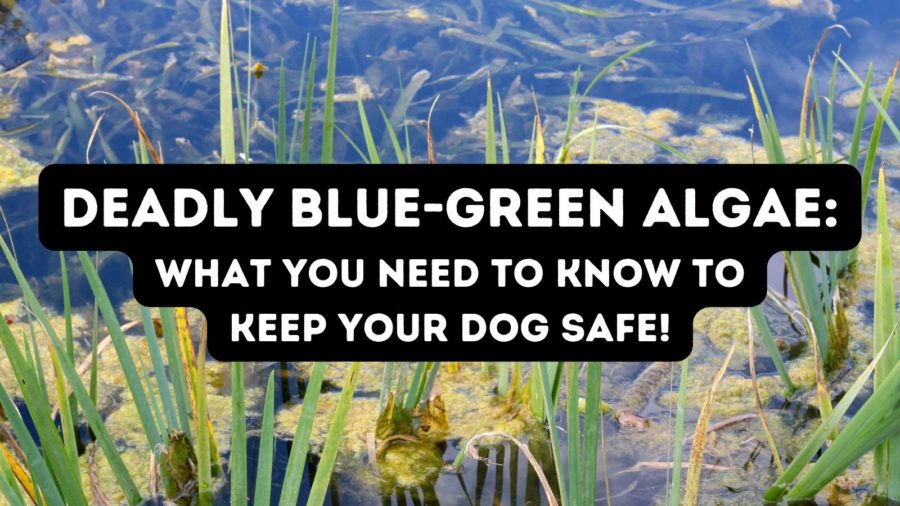
Summers are hotter than hot here in Texas–so, of course, nothing is more fun than to take the dogs for a swim. Sadly, recent summers have been tragic for numerous pet families due to dog deaths caused by exposure to blue green algae in the water.
When the dangers really came to the attention of local residents, Austin’s downtown Lady Bird Lake–and the off-leash Red Bud Isle–had to be closed to all dog swimming–but this is far from just an Texas concern for dog lovers.
In the same week, three dogs–in the same family–passed away following an evening play session at the EDGE of a pond contaminated with blue green algae in Wilmington, North Carolina.
How can you keep your dog safe from this blue-green algae that’s toxic to dogs?
What is Blue Green Algae?
Strangely enough, Blue Green Algae isn’t an algae at all but Cyanobacteria, a phylum of bacteria that’s present in warm water–lakes, rivers, and ponds. It can be found in freshwater, brackish water and saltwater.
It’s often the result of the warm water combined with fertilizers, septic fields, and agricultural or storm runoff to form a breeding ground for this toxic bacteria.
What does blue green algae look like?
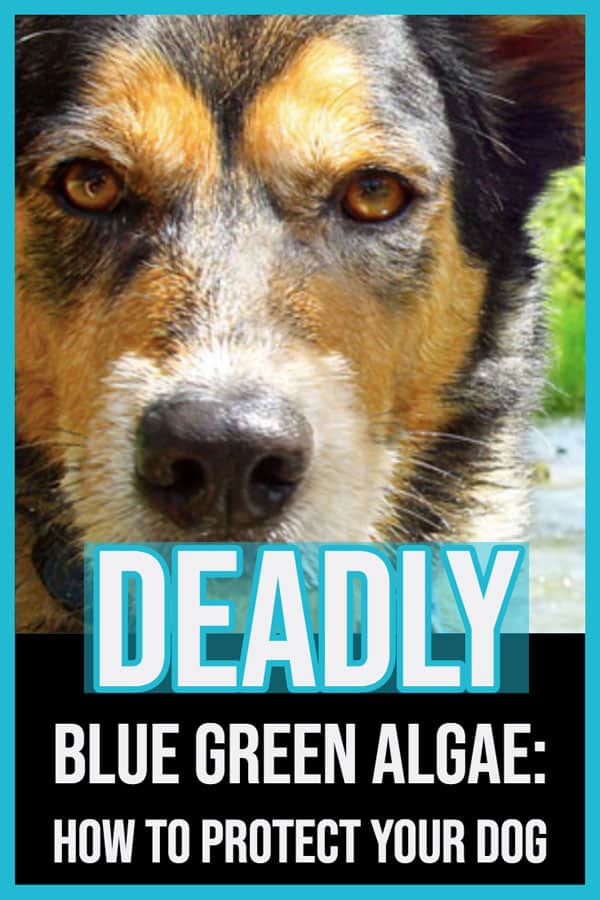
Here’s where it gets tricky–it is so difficult to know what is blue green algae and what is harmless plant life in the lakes and rivers.
In spite of its name, blue green algae can be many colors: green, red, orange, or brown.
Some photos of impacted areas show dense algae blooms that are visible above the water:
UPDATE: The City of Austin is closing Red Bud Isle on Lady Bird Lake to the public as of 3pm today. Tests show this blue-green algae is the type that can produce neurotoxins. 3 dogs have become paralyzed and died shortly after swimming in the lake. pic.twitter.com/9oOtWVQhGs
— Bettie Cross (@BettieCrossTV) August 7, 2019
But it’s not always so apparent. You’ll see in these photos–taken by the dog mom whose three dogs passed away after playing in the mud at the edge of this pond–that water contaminated with blue green algae can look quite clear:
Why is this bacteria so dangerous for dogs?
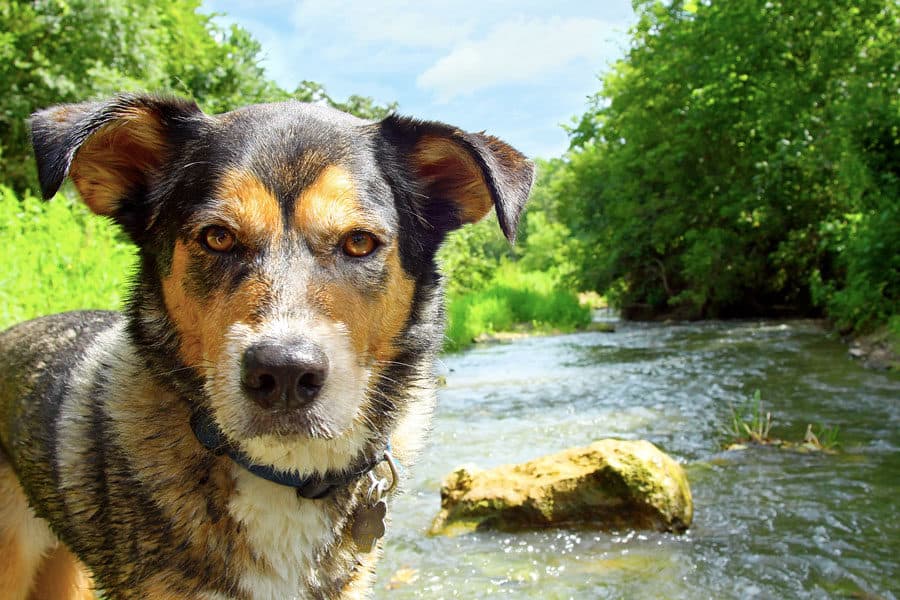
According to the Minnesota Pollution Control Agency:
Pets, especially dogs, are susceptible to harmful algae because they swallow more water while swimming and doing activities like retrieving a ball from the water. They are also less deterred by green, smelly water that may contain harmful algae.
Dogs also tend to lick off the water once they’re on land, additional intake of the potentially toxic substance.
The bacteria is also harmful to humans; in Austin, kayakers and canoeists are warned to rinse off immediately if they fall into the water.
What are the symptoms of blue green algae poisoning?
The symptoms of poisoning begin shockingly soon after a swim–sometimes even minutes later. This KVUE article lists this signs that you should be aware of if your dog has been for a swim.
If you see any of these signs, head to your veterinarian or an emergency veterinarian:
- Excessive drooling, vomiting, diarrhea
- Foaming at the mouth
- Jaundice, hepatomegaly
- Blood in urine or dark urine
- Stumbling
- Loss of appetite
- Photosensitization in recovering animals
- Abdominal tenderness
- Progression of muscle twitches
- Respiratory paralysis
If your dog does come into contact with water you may believe contains blue green algae, work quickly.
“If your pet does accidentally come in contact with the water, bathe them immediately,” said Sara Hartley, an assistant director with Austin’s watershed protection department in an interview with CBS Austin following the closure of Red Bud Isle.
Don’t wait to get home to bathe your dog with dog shampoo; immediately rinse your dog off with fresh water. You can give your dog a better bath when you get home but first it’s most important to get that algae off your dog’s fur so he won’t lick it off on the way home.
What do experts say?
Texas A&M AgriLife Extension Service aquaculture expert has offered information on this topic that has worried so many dog lovers:
Todd Sink, Ph.D., AgriLife Extension aquaculture specialist, College Station, wanted to address recent stories involving companion animal deaths linked to toxins in surface water to assuage fears and provide information to help the public protect themselves and their animalSink is also Texas A&M University Wildlife and Fisheries associate department head and program leader, and director of the Texas A&M AgriLife Extension Aquatic Diagnostics Laboratory.
Sink said cyanobacteria, or blue-green algae as they are often incorrectly referred, are everywhere in the environment, and exist in virtually every single body of water in the world. There are hundreds of different species in the U.S. alone.
His office has been inundated with emails regarding cyanobacteria and how to test for it since national news agencies picked up on and began running stories of a series of dog deaths that occurred after they swam and/or drank from contaminated water undergoing a toxic cyanobacteria bloom. The deaths first started in early August with three dogs that swam in a pond at Lady Bird Lake in Austin, followed by more deaths in Wisconsin and North Carolina.
“Many people are very concerned regarding the safety of their dogs in the wake of these national news stories, which in my opinion is sensationalism to attract an audience,” he said. “So far seven to eight dogs out of the millions of dogs in the U.S. have died due to toxic cyanobacteria blooms this year. These are localized, isolated incidences.
“As a fellow dog owner, I sympathize with those who tragically lost their beloved pet. However, thousands more dogs in the U.S. die every year due to preventable illnesses or conditions such as heartworms, heat stroke, starvation, exposure, accidental poisoning or being run over by a vehicle. Sensationalizing these cyanobacteria-related deaths has only served to scare dog owners.”
Sink said he typically receives six to eight cases of livestock or wildlife deaths due to cyanobacteria toxicity per year at the Aquatic Diagnostic lab.
“There are 1.3 million ponds in the state of Texas, and the vast majority of livestock animals are solely reliant on these as a source of drinking water, yet I only receive six to eight cases a year,” he said.
Sink and other AgriLife experts suspect as many as an additional six to 12 livestock cases go unreported per year because producers may not know cyanobacteria could be a potential source of toxicity. But prior to this year, Sink had only received one suspected case of cyanobacteria toxicity in a companion animal such as a dog in the last five years.
He has received dozens of requests to test surface water that dogs swim in in the past two days and believes the surge in requests is due to fear generated by news stories.
Red flags that blue green algae is present
In most cases, there is no need to fear allowing pets to play in bodies of water, nor is there necessarily a need for owners to submit samples for expensive testing, Sink said. There are other no-cost common-sense methods to protect their pets.
The first is to learn to detect and identify cyanobacteria, he said.
“The first thing you should know is the presence of a bluish-green surface scum or mat is an immediate red flag, and you should not allow your animals to swim in or drink the water,” he said.
For images of cyanobacteria including bluish-green surface mats and scums and more identification features and prevention and management options see the AquaPlant website.
The blueish-green color is a clear sign of cyanobacteria, but the absence of this color in most cases means absolutely nothing because most cyanobacteria are not blue-green. Most species are various shades of green or brown and some even have a reddish tint, so color alone cannot be used to identify cyanobacteria.
Most harmless, single-celled green and brown algae species are suspended within the water at various depths. Under bloom conditions, many cyanobacteria on the other hand, form non-filamentous surface scums that can be an extremely thin layer that is almost sheen-like, to thick and highly visible in areas where the wind has blown and concentrated them.
“So always check the surface of the water against the bank on the downwind side of the pond before allowing a pet to swim or drink the water,” he said.
The absence of these surface scums does not mean the water is safe, as many toxin-producing cyanobacteria species are filamentous and can be mixed in with typical harmless species of filamentous algae that form dense floating mats during summer months. But these species are difficult to detect or differentiate visually, he said.
Another clear red flag can be dead aquatic species, such as fish, including small minnows, frogs and turtles, along the shoreline, Sink said.
Due to their prolonged exposure time and direct exposure of vital respiratory organs, or gills, to the toxin contaminated water, fish are likely to die and be observed prior to any observed issues with animals that drink from the pond.
“Cyanobacteria identification can be difficult even to the experienced eye,” Sink said. “There are other signs a pet or livestock owner should look for. But in general, if no dead or dying fish are observed or have been recently reported from the body of water, it is not likely a cyanobacteria bloom is actively producing a toxin.”
Another red flag indicating the presence of cyanobacteria are small, irregular, round or egg-shaped clumps of dark green or dark blueish-green algae that float along at the surface and may form mats along wind-blown edges of ponds, Sink said.
The genus Microcystis, which produces the potent hepatotoxin microcystin-LR, often starts as a fine film or scum at very low densities during the initial phase of a bloom and forms round or egg-shaped, gelatinous, floating clumps after the population density increases.
“If uncertain, as a general precaution pets should not be allowed to swim in or drink from any waterbody that is intensely green or blue-green in color due to an obvious high density of algal cells,” he said. “Ninety-nine times out of 100, this high density of algal cells is due to a bloom of harmless green or brown algae or even non-toxin producing cyanobacteria, but that cannot be ascertained simply by looking at it. It may be a bloom of toxin producing cyanobacteria or have toxin producing cyanobacteria mixed in, so it is best that your pet avoids it.”
Testing suspected water
Testing is not always the answer as testing consists of two parts, Sink said. The first is a visual identification in which a person trained in algae species identification microscopically examines a water sample, carefully inspecting it to determine if cyanobacteria cells are present, how many cyanobacteria species are present and at what density of each cyanobacteria is present. This only tells half the story.
If it is determined that toxin-producing cyanobacteria species are present in the sample at high concentrations, the second step is to test to determine if cyanotoxins are present. If so, then it’s necessary to determine what type of toxins and at what concentration is each toxin present.
“There are several different types of cyanotoxins that may be present and each one must be tested and quantified individually,” Sink said. There is no overall test to measure total toxicity or toxins present. This is the only way to determine the potential toxicity of the water to animals that drink it or swim in it.”
Therefore, testing can become quite expensive, Sink said. The average water sample will cost $450-$500 to test.
Another issue is having a sample tested only provides a single snapshot in time, he said.
“Just because no toxins were found in a sample that was tested today does not mean there weren’t any toxins present the week before, and it certainly does not mean there won’t be any toxins present tomorrow, next week, next month or next year.”
If the landowner understands the costs of testing and wishes to have a test performed, they can submit a sample to the Aquatic Diagnostic Laboratory. Go to the Texas A&M AgriLife Extension Aquaculture, Fisheries and Pond Management website and click on the Aquatic Diagnostics Laboratory tab at the top of the page for instructions on how to submit a sample.
Texas A&M performs the first half of the testing in house as described above. If significant quantities of toxin-producing species of cyanobacteria are determined to be present in the sample, the lab then outsources the toxin testing to one of a handful of national laboratories that have the capability to test for and quantify specific cyanotoxins present in the sample.
Of course, if no, or low quantities of toxin producing cyanobacteria are present in the sample, the lab will not submit the sample for toxin testing and quantification and will only bill for the first portion of the testing, Sink said.
Types of toxins
Not all cyanobacteria species produce toxins, Sink said. Some produce toxins, but not toxins that are lethal and rather cause minor skin and mucous membrane irritation.
Some species produce a single toxin that if ingested can be fatal, while others produce multiple toxins that can be fatal if ingested. However, the type of toxin and the quantity of toxin produced and ingested determines if it will be fatal to a dog compared to deer, a horse or a cow.
“Body size, species and physiology of the animal that ingest toxins are major factors,” he said.
Different species of cyanobacteria produce different toxins, including cytotoxins, endotoxins, hepatotoxins and neurotoxins, which are collectively known as cyanotoxins, Sink said.
Endotoxins are typically the least toxic and only become problematic after ingesting large quantities of the live cyanobacteria, and typically result in intestinal discomfort, vomiting and diarrhea.
Cytotoxins are typically low to moderate in toxicity causing minor to moderate irritation of the skin and mucous membranes.
Hapatotoxins are highly toxic resulting in severe liver damage and potential failure, but typically require repeated ingestion of contaminated water as the toxins build up in the liver over time and results in death in hours to days.
Neurotoxins are highly toxic and can result in failure of the neurological system resulting in heart cessation and breathing failure in minutes to hours.
To further complicate the issue, Sink said cyanobacteria species that do produce these toxins, do not produce them all the time.
“There can be a large number of cells per milliliter of water of these toxin producing bacteria, but as long as nutrients are not limiting and environmental conditions remain favorable, they will not produce toxins,” he said. “Cyanobacteria typically produce the toxins under ‘bloom’ conditions.”
Cyanobacteria blooms typically occur under hot, dry conditions in which water becomes more stagnate due to lack of incoming water or rainfall. These conditions tend to evaporate large quantities of water leaving behind and concentrating nutrients in the remaining water, causing blooms, where cyanobacteria multiply very rapidly and become highly concentrated in the water.
“When bloom conditions occur, eventually the rapidly growing cyanobacteria population will suddenly exhaust the nutrient supply available,” Sink continued. “It is under these conditions that they become the most dangerous and produce the most toxins.”
Cyanobacteria developed cyanotoxins as a defense mechanism against zooplankton predators, and to limit competition for nutrients and sunlight from other planktonic microorganisms such as green and brown algae and diatoms, Sink said.
“As the nutrients begin to run out under bloom conditions and competition for sunlight increases, cyanobacteria increase their production of toxins to eliminate their competition,” he said. “So only under certain conditions in certain situations, do some cyanobacteria, or blue-green algae, produce toxins at concentrations that may become dangerous to companion animals, wildlife, livestock or humans.”
Regardless of where you live, please take a few moments to check for algae before you let your dog in or around the water this summer, one way you can keep your dog safe at the lake or river!
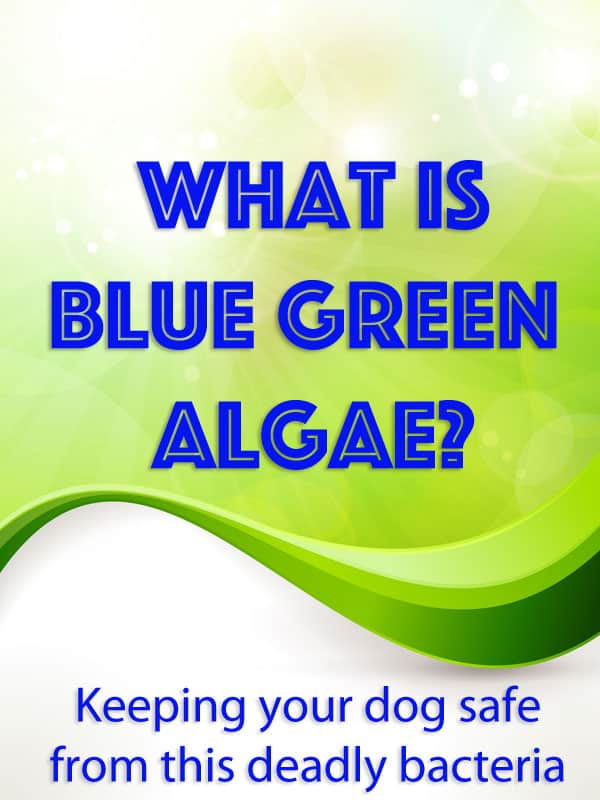
Pin it to Remember
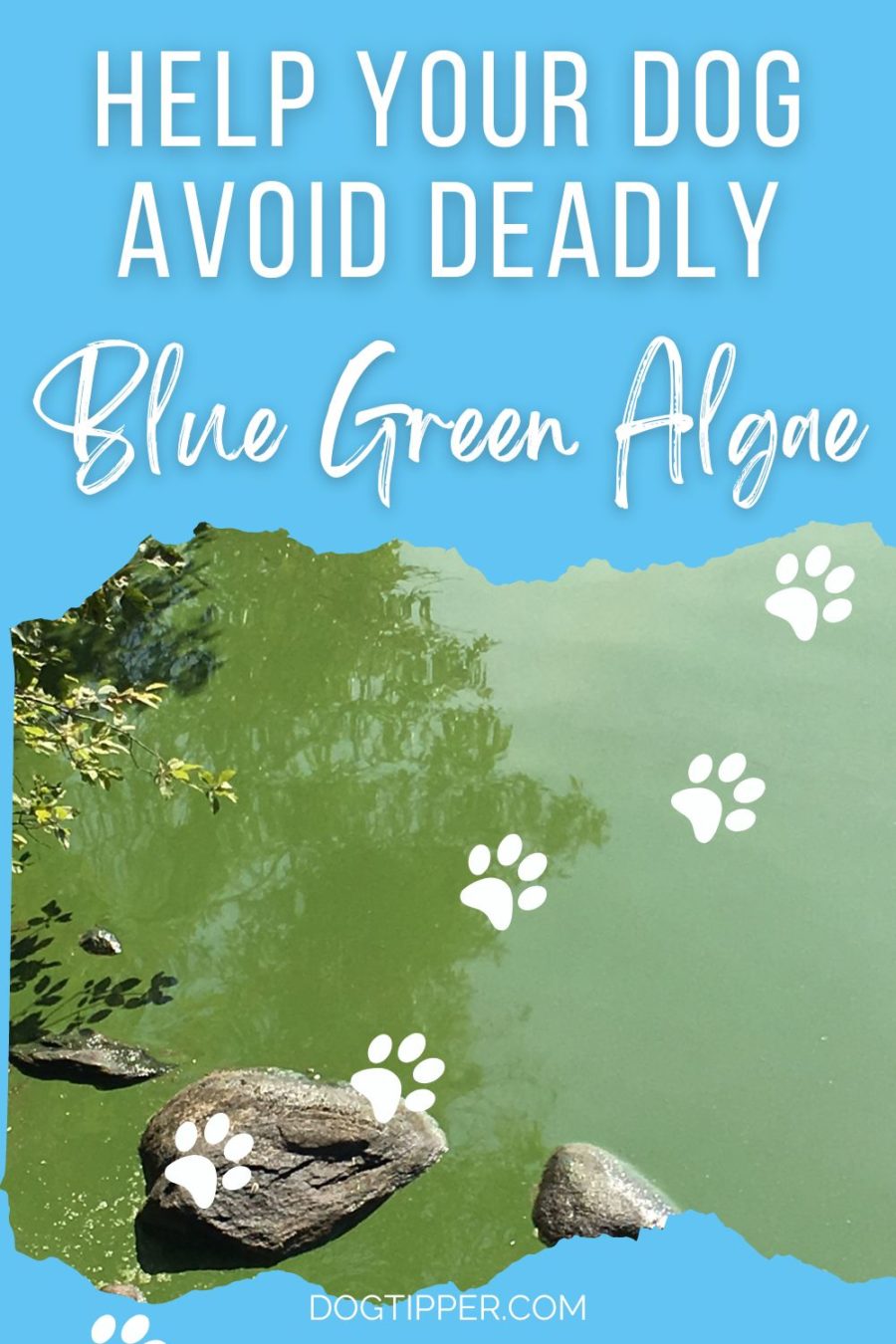
- National Conservation Dog Day - January 8, 2026
- 8 Tips to Turn Your Dog Picnic Into an Enrichment Activity - January 7, 2026
- Review: Jimmy BX7 Pro Anti-Mite Vacuum Cleaner - December 16, 2024
